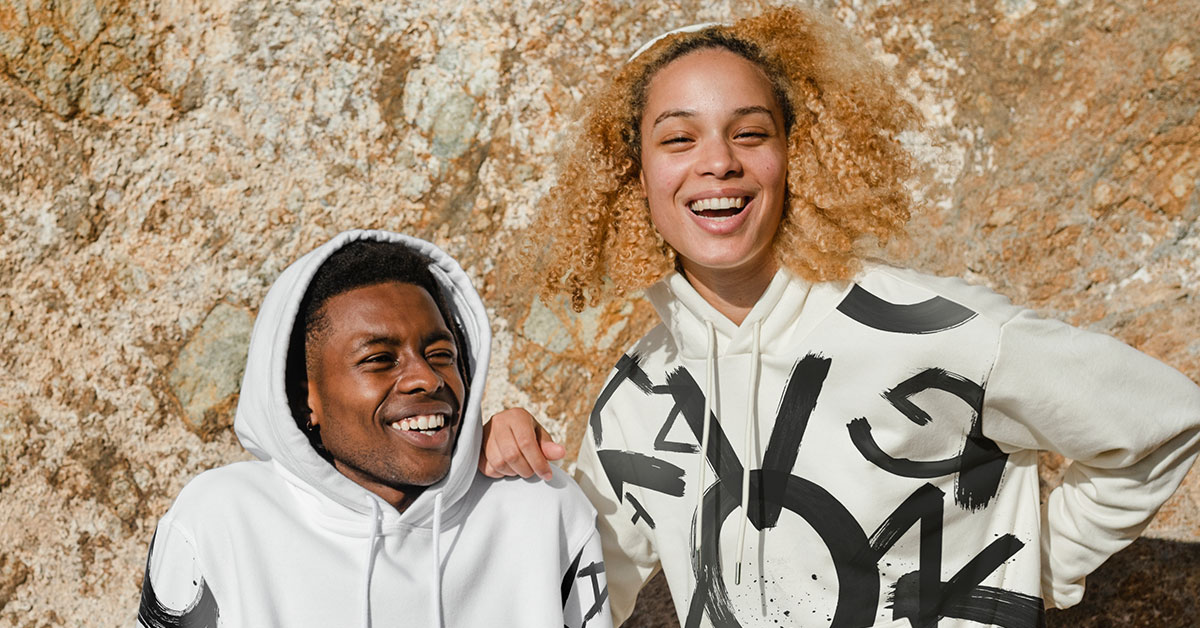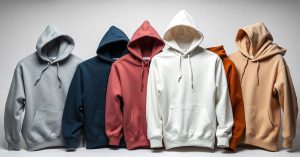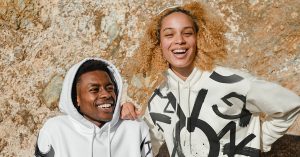In the rapidly evolving world of custom apparel, the quest to find the perfect balance between upfront cost per unit, visual print quality, and enduring durability for your garments is paramount. Whether you are a small business launching its first hoodie line, a designer working on an exclusive drop, or a major clothing manufacturer handling immense bulk orders, the question remains: Which printing method offers the best mix for your specific project? Is it the classic, texture-rich screen printing, or perhaps the advanced technology of the newer DTG and DTF processes?
This definitive guide is engineered to assist Apparel brands, small businesses, and discerning designers in choosing the right approach for their hoodies. We offer a comprehensive comparison of seven of the most popular hoodie printing methods, including screen printing, Direct-to-Garment (DTG), sublimation, heat transfer vinyl, Direct-to-Film (DTF), and textured embroidery, alongside valuable insights into when to opt for custom-printed hoodies versus other custom options. You will uncover practical tips, such as understanding precisely when screen printing becomes more economical than DTG printing, why sublimation is absolutely essential for polyester performance hoodies, and the specific circumstances where embroidery or various hybrid printing technique options can provide a premium, truly long-lasting finish.
Table of Contents
Types of hoodie printing: overview and how to choose the best printing method
The decision to choose the most suitable for printing technique begins with a fundamental question: What is the most critical factor for this specific project? You must meticulously consider elements such as the overall feel, the desired aesthetic look, and the ultimate financial budget. The correct choice of type of printing dramatically influences the garment’s hand-feel, its anticipated durability over time, and, most crucially, the final cost per unit.
Why choosing the right printing technique matters for hoodies
The selected printing method fundamentally alters both the tactile feel and the ultimate longevity of the hoodie. For instance, modern streetwear often benefits from the smooth, flat finish of various print options, while a subtle, textured embroidery application instantly conveys a more premium feel, particularly for small logo placements. Making the wrong choice can lead to a host of problems, including premature cracking or peeling of the design, color fading after just a few washes, or an undesirable stiffness in the fabric.
Key factors: cost per unit, durability, print quality, fabric compatibility
The cost per unit is inherently dynamic, shifting significantly based on the volume of the bulk orders. Screen printing, due to its economies of scale, is generally more Cost-Effective for Bulk quantities, while Direct-to-Garment (DTG) and Direct-to-Film (DTF) are better suited for small quantities. Conversely, simpler heat transfer and cut vinyl methods are excellent options for one-off custom hoodie jobs.
Durability is absolutely critical for ensuring optimal customer satisfaction and a positive brand reputation. Properly cured screen prints and quality embroidery are known for surviving numerous wash cycles. Sublimation printing performs exceptionally well on polyester by integrating the color permanently into the fibers. The longevity of a DTG print, however, often depends significantly on the type of ink used, the precision of the curing process, and the specific fiber content of the fabric itself.
Both print quality and fabric compatibility are equally important factors. For highly detailed designs, either DTG or DTF is typically the best printing method available. Screen printing excels at producing intensely vibrant colors. When working with polyester and technical performance fabrics, sublimation is the clear and superior choice. Finally, heavy fleece hoodies are often the most ideal canvas for quality embroidery.
How design complexity and color requirements change the best printing method
Designs that feature high Design Complexity absolutely require printing method options capable of capturing fine detail accurately. For intricate, multi-color prints, especially in small quantities, DTG or DTF techniques are the most advisable route. Conversely, when the goal is to produce bold, simple logo designs in massive quantities, traditional screen printing is generally the better, more scalable choice. It is worth noting that a large number of spot colors necessitates more setup time with screen printing, which can unexpectedly raise the price for mid-sized runs. For those aiming for full-color, all-over graphic coverage on a polyester garment, sublimation printing remains the definitive, top choice for enduring color integration.

1. Screen printing for hoodies: cost-effective for bulk orders and vibrant colors
Screen printing is undoubtedly the perennial favorite for established fashion brands that require consistently bold, highly opaque prints on hoodies and other heavy garments. This process involves forcing a thick layer of specialized ink onto the fleece and cotton blends of the hoodies through a finely stretched Mesh Screen. While it is true that every distinct color in your hoodie design mandates the creation of its own screen, which inevitably contributes to the initial setup cost, the final results are unmatched in their tactile feel and excellent durability.
How it works
The fundamental process involves placing a precisely created stencil onto a mesh screen, after which the ink is pushed through the open areas directly onto the fabric. For any design featuring multiple colors, a completely new screen must be set up and carefully aligned for each layer. This layered approach is precisely what allows this printing method to create dense, solid, and incredibly vibrant colors that pop against the background, even on darker hoodies.
Advantages
For bulk orders, screen printing is unequivocally the cheapest printing technique on a per-unit basis, making it the most sensible choice when producing thousands of apparel items. The resulting prints are characteristically thick, highly durable, and spectacularly showcase vibrant colors with excellent opacity, performing particularly well on thicker, heavy-weight fabrics. This method’s durability is generally superior to most other options, ensuring the design will be long-lasting.
Drawbacks
The need for significant upfront time and financial investment in the initial setup of the screens can render small quantities quite expensive. Furthermore, this method is not typically well-suited for extremely complex designs or photorealistic imagery because of the time and cost associated with separating and aligning each individual color. For intricate artwork, the cost rapidly escalates when the color count exceeds four or five.
Best uses
Screen printing is ideally suited for massive bulk orders such as wholesale t-shirts and hoodies, particularly for simple logo placements and large volume streetwear lines. It is clearly the best method for brands that prioritize low overall cost, color consistency, and superior durability across their largest campaigns.
2. Direct-to-Garment (DTG) printing: high-detail prints and full-color designs
Direct-to-Garment (DTG) printing is a cutting-edge printing method that utilizes specialized inkjet technology to deposit color onto the fabric with surgical precision, much like a standard paper printer. This innovative approach is especially valuable for designs that feature soft gradients, full-color imagery, and complex artwork that would be prohibitively expensive to separate for traditional screen printing.
DTG printing process
A high-tech inkjet printer specifically engineered for textiles sprays specialized water-based pigment inks directly onto the garment as it rests flat on a platen. When working with darker hoodies, a necessary pre-treatment primer is applied beforehand to help the ink bond securely with the fabric fibers and ensure color vibrancy. Following the printing step, a final heat and pressure curing cycle permanently fixes the inks so that the design can withstand the rigors of routine laundering.
Pros
Direct-to-Garment excels at producing truly full-color, high-detail prints without any practical limit on the number of colors used. This allows artists and small fashion brands to achieve stunning photographic-print quality results easily. Because the setup cost is low, this printing method is perfectly tailored for print-on-demand platforms, custom hoodie services, and one-off small quantities where the initial barrier of screen printing would be too high.
Cons
On a per-piece basis, DTG operates slower than screen printing, making it significantly less cost-effective for large production volumes. The ink adhesion is strongest on fabric with a high-cotton blend, with results being variable on polyester or purely synthetic materials, which may cause the design to fade over time. While proper curing and the use of premium inks enhance durability, they cannot entirely eliminate the risk of gradual fading that is inherent to the process.
When to choose this method
You should choose the DTG printing method for all small quantities and when your hoodie design features extremely complex designs that require accurate color and intricate detail. It is the ideal fit for limited-edition custom hoodies, artist drops, and for any business model relying on print-on-demand fulfillment. Many larger apparel fashion brands will often pilot new concepts using DTG before scaling up to screen printing for their massive bulk orders.
3. Sublimation printing and sublimation printing on polyester garments
Sublimation printing is a completely unique process that harnesses intense heat and pressure to transform solid dye into a gas, effectively bypassing the liquid stage. This gas then fully permeates the fibers of the polyester, resulting in a vibrant print that is permanently integrated and feels completely smooth to the touch. Leading apparel companies, particularly in the activewear sector, leverage this technique extensively due to its remarkable performance on synthetic fabrics and its ability to deliver exceptionally vibrant colors.
How the process bonds color to fabric
The application of Heat and Pressure causes the solid dye to transition into a gaseous state, which opens the pores of the polyester fibers and allows the gas to bond chemically with the synthetic material. Once the garment cools, the pores close, locking the color permanently inside the fibers. This sophisticated process creates photorealistic, truly long-lasting prints that are utterly resistant to cracking, peeling, or fading, which is a common issue with surface-level prints.
Advantages for athletic and full-coverage designs
Sublimation printing is the premier choice for achieving seamless, all-over prints with no discernable edges or weight. Since the dye becomes part of the fiber, it is ideal for athletic hoodies made of polyester, as it completely preserves the fabric’s essential moisture-wicking and stretch performance characteristics. Designers can expect astonishingly bright, vibrant colors that maintain their saturation and clarity even after countless washing cycles, providing maximum durability.
Limitations to consider before choosing this method
A key constraint of sublimation is its strict requirement for polyester or specialized polyester-coated fabrics. It is not a viable type of printing for traditional cotton hoodies and is not suitable for darker hoodies unless they have a specially prepared white polyester base layer. The final color result is also dependent on the whiteness and base color of the fabric, making it less flexible than other methods.

4. Heat transfer methods: vinyl, paper, and direct-to-film (DTF)
Transfer printing is a versatile and highly accessible category of printing method that is highly favored by small shops and designers who need to produce finished garments quickly without incurring large setup costs. This process involves printing a hoodie design onto a transfer medium and then applying it to the hoodie using a heat press machine. This approach is excellent for quickly creating personalized custom hoodies and limited editions.
4a. Vinyl Heat Transfer
Vinyl is a highly durable material that is cut into the desired logo or font shape using a specialized cutter. It is then applied to the fabric using precise Heat and Pressure. This method is exceptional for crisp, sharp edges and single-color bold designs, which are often utilized for sports numbering, small logo placements, and sleeve prints on custom-printed hoodies. The main drawback is that layering vinyl can lead to a thick, sometimes heavy, feel on the fabric.
4b. Heat-Transfer Paper
This common printing method involves using a standard inkjet or laser printer to print a design onto special transfer paper. The design is then transferred to the hoodie with a heat press. This is an incredibly cost-effective solution for quick, one-off full-color prints on a variety of substrates. However, the durability can be variable, and lower-quality paper often results in a stiff or plasticky feel that can peel prematurely.
4c. Direct-to-Film (DTF)
Direct-to-Film (DTF) represents a more modern printing technique that functions as a high-quality hybrid. This process involves utilizing an inkjet printer to print the design onto a specific film, followed by the application of a powdered adhesive that is then cured. This final transfer printing film is then applied to the garment with high Heat and Pressure. DTF provides highly detailed designs and significantly stronger adhesion than older paper transfers, making it highly effective for vibrant full-color graphics on both light and darker hoodies. It is widely considered a best printing method for limited runs due to its convenience and superior print quality compared to simple transfers.

5. Embroidery on hoodies: premium durability and textured branding
Embroidery instantly elevates the perceived value of hoodies and apparel, lending an air of sophistication and tactile luxury. Unlike traditional printing method options that use ink, embroidery is a technique that physically uses an Embroidery Machine to stitch the design into the fabric using thread. This process creates a distinctly raised, three-dimensional, and detailed texture that is synonymous with high-end quality.
Embroidery process
The specialized embroidery machine follows a precise digital file to sew the desired logo or artwork directly onto the hoodie. This allows for the addition of various elements, such as patches or appliqués, while also controlling the density and tension of the stitches to create a thick, substantial feel. The texture of the stitching provides a truly stylish and timeless finish.
Pros
The primary advantage of embroidery is its exceptional durability and ability to withstand extensive washing and wear without degradation, far exceeding most print methods. It consistently projects a high-end brand image, making it the best method for corporate wear, uniforms, and small logo placements on the chest, sleeve, or collar. It is universally considered a long-lasting and premium option.
Cons
Since embroidery involves physical thread, it is not suitable for achieving smooth color gradients or photorealistic imagery like ink printing is. Extremely fine or detailed designs may be lost or rendered illegible due to the physical limitations of the thread size. Additionally, the sheer weight of the threads can cause issues on very thin fabrics, and the necessary process of punching needles through the material makes it inappropriate for waterproof garments.
Best uses
Embroidery is the ideal type of printing for small logo designs, professional corporate apparel, patches, and sleeve badges. It is the perfect choice for brands that want their hoodies and Custom Apparel possess a truly premium, tactile aesthetic that is built to last for many years.
Comparing cost, quality & durability across printing methods for hoodies
Ultimately, choosing the right printing method for your custom-printed hoodies comes down to balancing three major factors: bulk orders volume, the fabric composition, and the complexity of the hoodie design. For instance, screen printing will almost always be the most cost-effective choice when dealing with very large volumes, but DTG and DTF justify their higher initial cost by offering superior detail on smaller runs. Heat transfer methods, including vinyl, are excellent for one-off and promotional items, even though they can add a heavier feel to the garment.
To assist in your decision-making process, the table below provides a concise comparison of the key performance indicators for the most popular types of hoodie printing:
Printing Method | Best for Order Volume | Best Fabric Compatibility | Quality of Detail & Colors | Durability Rating (1-5, 5 being highest) |
Screen Printing | Bulk Orders (50+ units) | Cotton, Cotton/Poly Blends | Excellent Opacity, Vibrant Colors | 4/5 |
Direct-to-Garment (DTG) | Small Quantities, Print-on-Demand | High-Cotton Blends (100% preferred) | Photographic, Full-Color, High-Detail | 3/5 (Variable) |
Sublimation Printing | Any Volume | Polyester (100% preferred) | Seamless, All-Over Prints, Photo-Quality | 5/5 (Permanent) |
Vinyl Heat Transfer | One-offs, Small Runs | All Fabric Types | Crisp Edges, Single-Color Boldness | 3/5 |
Direct-to-Film (DTF) | Small to Medium Runs | Cotton, Poly/Cotton Blends | High-Detail, Full-Color on Darker Hoodies | 4/5 |
Embroidery | Any Volume (Low for high stitch count) | Heavy-Weight Fabric | Textured, Premium, Raised Feel | 5/5 (Permanent) |
Final Recommendations: Choosing the Best Printing Method
The best choice depends entirely on your specific project needs. Use the following recommendation table as a quick reference when planning your next line of custom hoodies:
Project Goal | Recommended Printing Method | Why it is the Best Method |
Cost-Effective Production for Bulk | Screen Printing | Lowest Cost per Unit due to efficient setup for high volumes. |
High-Detail Designs & Photo Prints | Direct-to-Garment (DTG) or DTF | Capable of true Full-Color and smooth gradients without screen limits. |
Premium Feel & Long-Lasting Logo | Embroidery | Durable and permanently stitched; adds stylish, textured dimension to the hoodie. |
Full-Color, All-Over Athletic Wear | Sublimation Printing | The only method that becomes one with the polyester fabric, ensuring breathability and long-lasting color. |
For a more granular view, consider the trade-offs between the two most common types of hoodie printing:
Feature | Screen Printing | Direct-to-Garment (DTG) Printing |
Initial Setup Cost | High (for screens) | Low (No screens required) |
Unit Cost at High Volume | Low | High |
Color Limit | Limited (1-12 colors per design) | Unlimited (Full-color/Photographic) |
Feel/Hand-feel | Thicker, slightly plasticky (best for opaque designs) | Soft, minimal feel (ink absorbs into the cotton fibers) |





